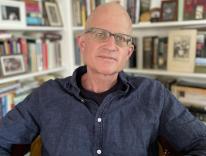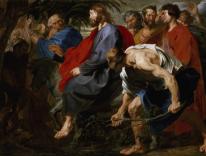
In 1992, David James Duncan published his breakthrough novel The Brothers K, a compelling and critically acclaimed chronicle of 1960s America. Inspired by Russian literature and America’s national pastime, the novel tells the story of the Chance family, a tight-knit clan made up of baseball fanatics on one side and, on the other, religious zealots. Baseball provides the novel with its main narrative framework (a “K” is a strike-out as well as an allusion to Dostoevsky’s Karamazov brothers), but religion is never too far removed from the action.
For many restless pew-sitters, the novel stands out for how masterfully Duncan translates the intricacies of a fundamentalist Christian family into material worthy of great literature. Kincaid, the youngest of the four Chance brothers, assembles the sprawling account of his siblings wrestling with their inner lives. Over the ensuing years their concerns move from box scores and Bible passages to the wisdom of Emerson, Thoreau, and the Upanishads. To satisfy their spiritual hunger, they reach deep within sacred tradition for the core tenets that are often muted by religious cultural trappings. But they also reach far outside of them. For the Chance children, spiritual inquiry and insight exist in the midst of their doofusy, screwed up, confusing church-school-household adolescence, not apart from it. The point for Duncan seems to be: keep your spirit awake in this world, not trained on the next.
Duncan expands this point in his long-awaited follow-up, Sun House, a novel more than twenty years in the making. Like The Brothers K, Sun House is a voluminous chronicle of a specific time in American history, this time spanning the turn of the twenty-first century, as the effects of unchecked capitalism and climate change start to take hold. Over seven sections, or “tellings,” the novel recounts the formation of the Elkmoon Beguine & Cattle Company, an unlikely collective of urbanites and ranchers—“broken-open lowly people”—and the fires and failures each member endures before joining this collective.
Strung together like “story beads,” the novel focuses on four main characters. Early on, we meet Risa McKeig, a University of Washington student studying—or, more accurately, falling in love with—Sanskrit and the Vedic spiritual tradition that introduces her to her own “infinite insides,” which inspires her efforts to “convert sadnesses into interior night sky.” We also meet the twins TJ and Jervis McGraff, whom Risa eventually befriends. TJ is a failed Jesuit-turned-chef, and Jervis is a street wanderer/preacher who serves as a kind of holy fool, moving events along and motivating others. A Shakespearean actor named Jamey Van Zandt, who enters the drama as a child grieving the death of his mother on his fifth birthday, eventually joins the group in Seattle.
The Pacific Northwest holds most of the action until the story ripples out to Colorado, where the folk singer Lorilee (Lore) Shay is having her heart won, then stomped on, and Montana, where Kale Broussard, a rancher and old soul, grieves the bygone days of his family’s estate in the Elkmoon Mountains. Kale holds fast to the belief that “the one way to preserve and defend a place’s rightness is to inhabit it, intimate, knowledgeable, and vigilant as can be,” even though the only way he and his crew can go on living in the place is to serve the absentee corporate stronghold that has bought them out. These Elkmoon Mountains also happen to be the childhood home of Dave McKeig, Risa’s failure of a father. Corralling the story is a narrator nicknamed “The Holy Goat,” or HG, an eventual member of the “unintentional menagerie”—not to be confused with an overly intentional community. Get too intentional or “thinky,” as Jervis says, and all the magic of this “Earth-gentle lifeboat” dissipates.
The novel plays with and stretches to high heaven the genre of the Western. Its many “embedded co-authors,” quoted extensively by HG, prefer the term “Eastern Western,” a genre in which “the timeless wisdom of the East touches the brokenness of the West.” We are also in the realm of the difficult-to-define genre of spiritual writing. Duncan unapologetically populates the bookshelves of his earnest characters with ancient texts and floods their conversations with excerpts. Every page is steeped in the world’s wisdom traditions, referencing or quoting directly from Buddhist master Eihei Dōgen; the Indian poet Valmiki and Vedic literature; the thirteenth-century Beguines, laywomen who lived and loved in community and who were fiercely persecuted by the Catholic Church; and the Beguines’ champion, the mystic Meister Eckhart.
As is the trademark of his fiction, Duncan’s spotlight shines brightest on the in-betweens and exceptions in religious tradition, the cracks. (The novel’s treasured Buddha statue, nicknamed Elmerina, is broken, its ear glued back on with Elmer’s.) The main spiritual “tradition” that thrives in the novel is Jervis’s “Dumpster Catholicism,” a large-hearted piecemealing-together of folks and ideas that mainline religions have trashed, excluded, or executed. Another trademark of Duncan’s work is humor, which he deploys liberally to take the air out of any spiritual gasbags. “No ego stinks worse than a spiritual ego,” one character notes. And Duncan isn’t afraid to be goofy, or even corny, to make sure his characters don’t stink up the joint.
Still, these wisdom-speakers strain the limitations of realism. Sages deliver long monologues to wean other characters from their “soul-diet of cornflakes” and press them on toward enlightenment. For example, the cantankerous and wise packer Gladys Wax advises a young hiker in the Elkmoons: “At elevation our imagination, consciousness, spirit, bodies are literally elevated. And elevation does things. Creates things. And uncreates other things. Again to our potential advantage. Elevation can unmake the mental ruts and overcrowding that trap our thinking.” Though some readers may balk at such sermonizing, the novel never swears by realism, and we discover in the very first chapters that the real and the supernatural almost always intertwine.
I get the sense Duncan has things he feels need saying and that it’s high time to say them, things about climate degradation, about institutions that bankrupt flesh and spirit, about ego, about a sustaining love that might help attentive humans survive calamity. And readers will need to be patient with Duncan and the large sections of esoteric texts he regularly quotes and his characters devotedly annotate in their “dumbsaint notebooks.” Their patience will be rewarded.
The heart of the novel is human relationships, both the betrayal that wrecks unions and the self-sacrifice that forges lasting loves. While Duncan is deeply interested in the “infinite insides” of humans and their relational drama, he is equally concerned with the vast interior life and dramatic situation of Earth herself, which is—as Duncan and his characters are painfully aware—in the throes of climate catastrophe.
The novel is at its best when it’s non-thinky and deeply immersed in scenes of self-giving in which “each person is out to be each other’s prayer answered,” or immersed in lush description of living landscape:
“The mountains enclosed her so decisively she felt like a passing thought inside their deathless mind. A few ravens strolled the yellowed grass like golfers, bending over frost-paralyzed grasshoppers as if over putts, only to swallow them whole. In the blue overhead the night’s billion stars hid behind light. On the smooth glides of the Elkmoon the rise rings were so bright they went on dazzling after she closed her eyes.”
Passages like this stud the seven-hundred-plus-page novel with spaces for silence and emptying-out. The best sentences honor what Risa calls “flame language,” the language beyond empirical thought. These emptied-out spaces attend moments like the death of a loved one, the release of a trapped hummingbird, and the gift of tiny dolls in a pouch. The deepest silence conveys the very presence of the mountains that hold these characters in thrall. Within that silence, a reader might discover that they can also lose themselves, just as Duncan’s characters do, then find themselves again in the vastness.
Sun House
David James Duncan
Little, Brown & Company
$35 | 774 pp.
Please email comments to [email protected] and join the conversation on our Facebook page.
Previous Story
Nolan Goes History Channel Mode
Next Story
A Toolkit, Not a Blueprint


